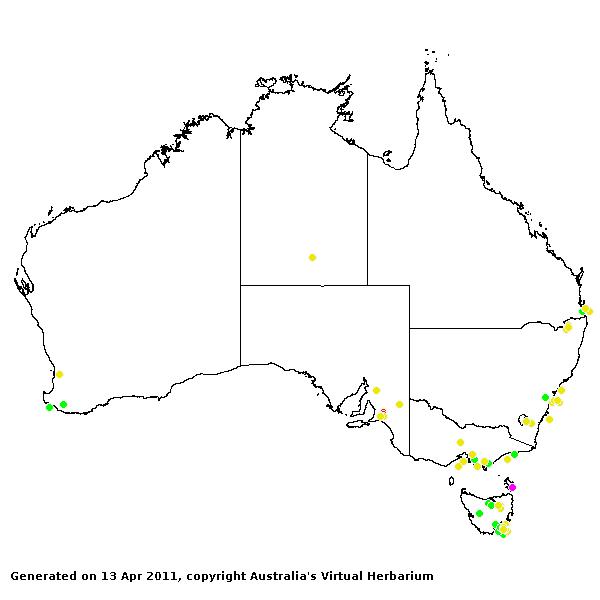Cortaderia* Gard. Chron. ser. 3, 22: 378 (1897).
Derivation:. An Argentinian name for pampas grass.
Taxonomic revisions, nomenclatural references:. V.D.Zotov, New Zealand Journal of Botany 1: 78–136 (1963); A.H.Harradine, Pl. Prot. Quarterly 6: 111–115 (1991).
Key references (keys and floras):. C.A.Gardner, Flora of Western Australia 1 Gramineae 131 (1952); E.E.Henty, Manual Grasses New Guinea 51 (1969) as Danthonia in part; J.P.Jessop, Flora of South Australia 4: 1854 (1986); S.W.L.Jacobs and S.M.Hastings, Flora of New South Wales 4: 565–566 (1993); B.K.Simon, Key to Australian Grasses 86–87 (1993); D.I.Morris, Student's Flora of Tasmania 4B: 318–322 (1994); N.G. Walsh, Flora of Victoria 2: 546–548 (1994);E.Edgar and H.E.Connor, Flora of New Zealand 5: 492–502 (2000); D.Sharp and B.K.Simon, AusGrass (2002); K.Mallet (ed.), Flora of Australia 44B: Poaceae 3: 22–26 (2005); J.P.Jessop, Grasses of South Australia 299 (2006); S.W.L.Jacobs, R.D.B.Whalley & D.J.B.Wheeler, Grasses of New South Wales, 4th Ed, 189 (2008).
W.D.Clayton & S.A.Renvoize, Genera Graminum (1986), genus (288).
Naturalised. 24 species, from New Zealand and South America. 3 species in Australia, WA, SA, Qld, NSW, Vic, and Tas. Also New Guinea.
Habit. Perennial, tufted (mostly large, tussocky). Culms woody and persistent. Leaf blades broad or narrow. Ligule a fringe of hairs or a fringe of hairs. Plants bisexual, with bisexual spikelets or dioecious (or gynodoiecious, with plant sexuality all alike on a plant (in Australia)).
Inflorescence. Inflorescence paniculate (large and plumose or small), an open panicle with branches ending in single spikelets, open.
Spikelets. Spikelets laterally compressed, more than 2 flowered, with 2 or more fertile florets, solitary, pedicelled; with naked rachilla extension. Fertile spikelets disarticulating above glumes.
Glumes. Glumes more or less equal, shorter than spikelet to about equal to spikelet (from 2/3 as long), long relative to adjacent lemmas, hairless, glabrous, pointed, awnless, keeled, similar (narrow, hyaline). Lower glume 1(–3) nerved. Upper glume 1(–3) nerved.
Florets. Fertile florets 2–3(–5). Lemmas attenuate, similar in texture to glumes to decidedly firmer than glumes (membranous or hyaline), not becoming indurated, entire at apex or incised, deeply cleft or not deeply cleft, awned or muticous, 3 nerved, hairy. Awns when awned, 1 or 3, the median similar in form to laterals (or somewhat more flattened, when laterals present), from a sinus or apical, non-geniculate to geniculate, hairless. Lateral awns when present, shorter than median. Lemma hairs in tufts or not in tufts, in transverse rows or not in transverse rows. Palea relatively long, entire (truncate), 2 nerved. Palea keels wingless. Distal incomplete florets underdeveloped. Callus long, pointed. Lodicules 2. Stamens 3 or 0 (in female plants of dioecious species). Hilum long-linear. Embryo large.
Kranz Anatomy. C3.
2n = 36, 72, 90, and 108, 4, 8, 10, and 12 ploid, commonly adventive.
Habitat. Mesophytic to xerophytic. Hillsides, in scrub and in weedy places. Species of open habitats.
Classification. Danthonioideae.
Notes. Gynodioecism (female and bisexual plants) encourages outbreeding, the sex ratios being maintained by poorer seed set and viability in bisexual plants. The genus intergrades with Chionochloa, and may be difficult to distinguish from it if only bisexual plants were available (Clayton and Renvoize, 1986).
Types Species. C. selloana (Schult.) Asch. & Graeb.
Biogeographic Element. Clifford & Simon 1981, Simon & Jacobs 1990: Naturalised.

